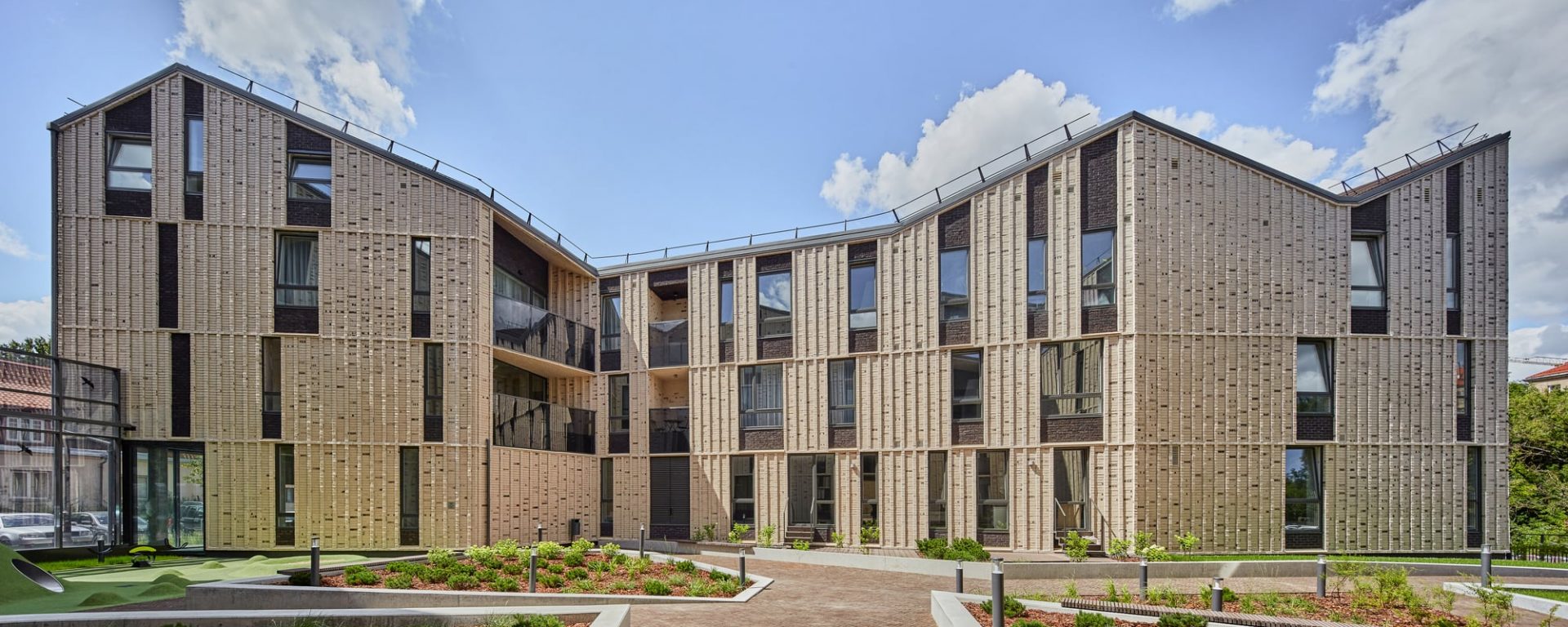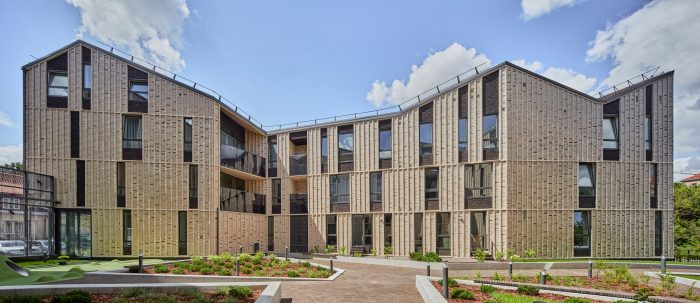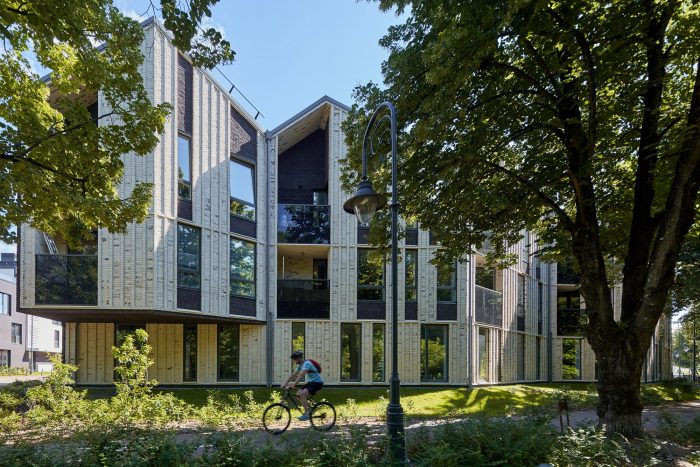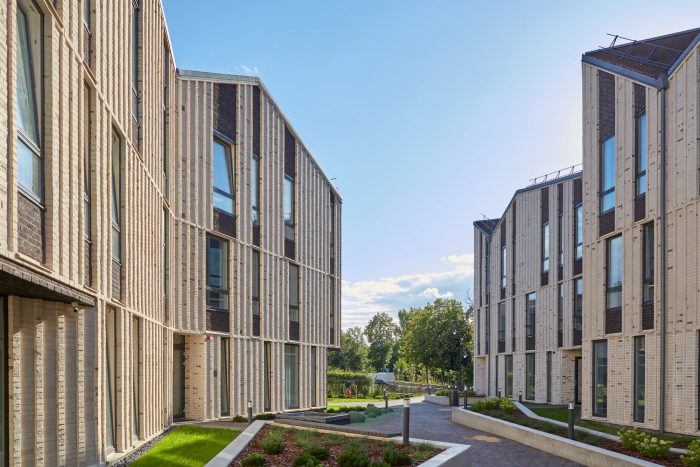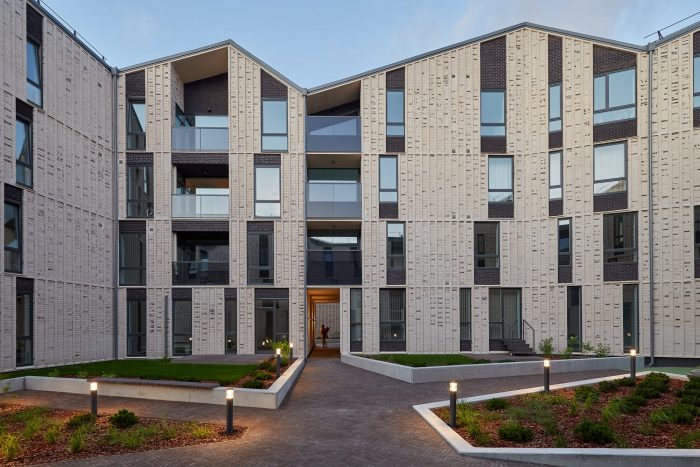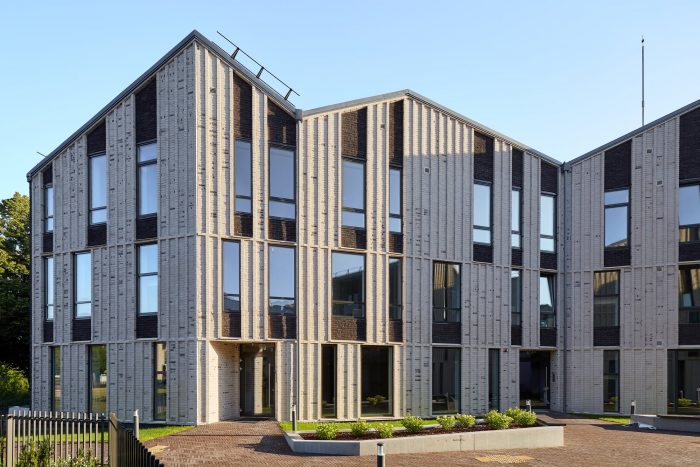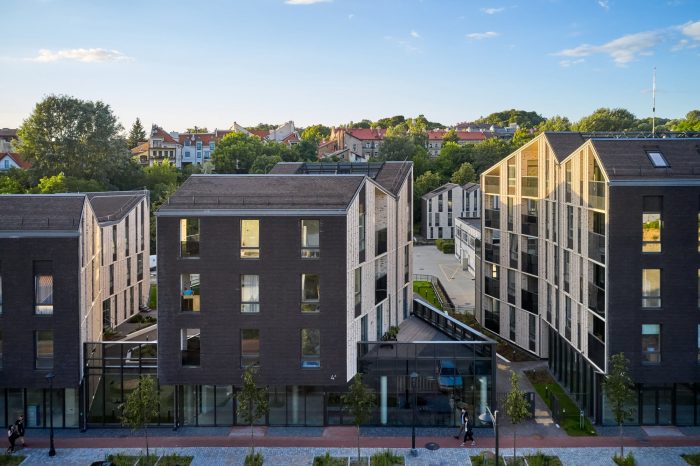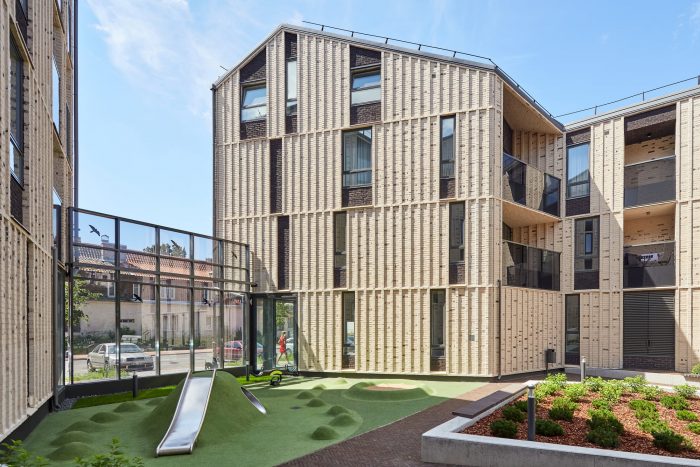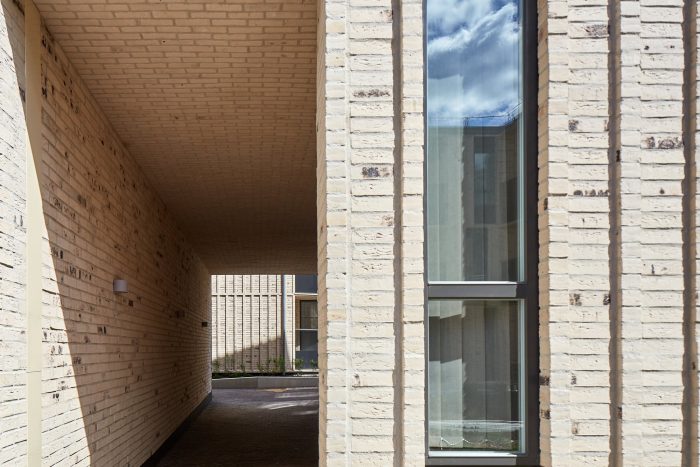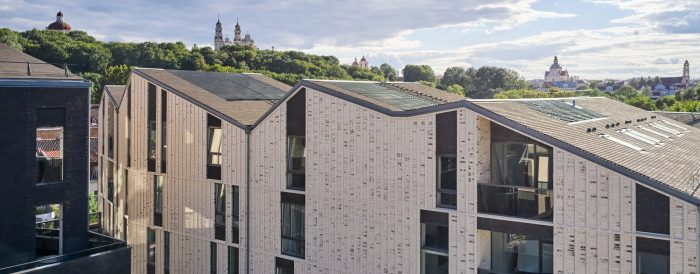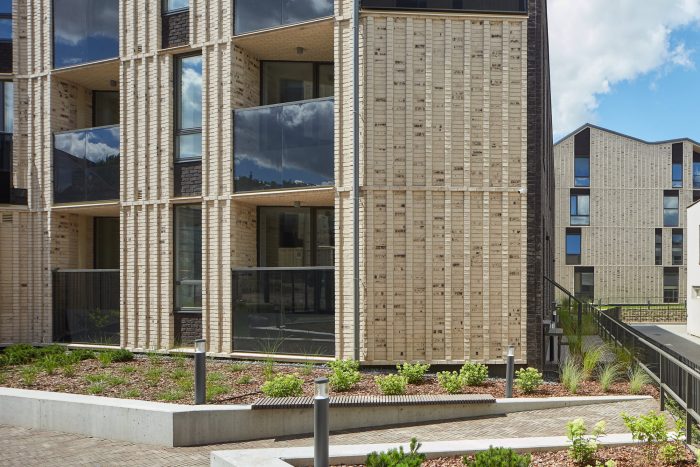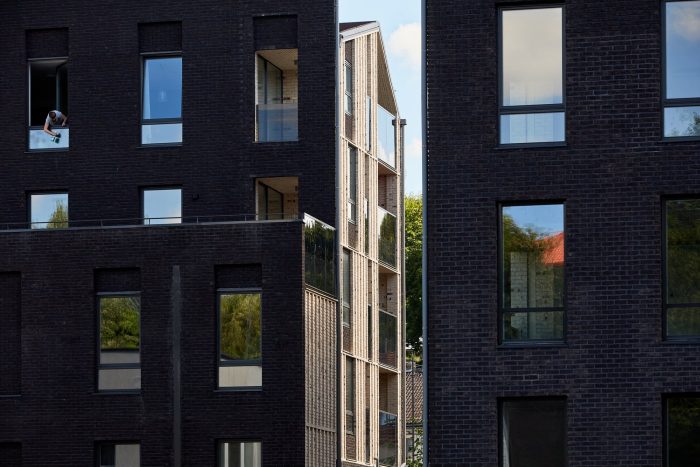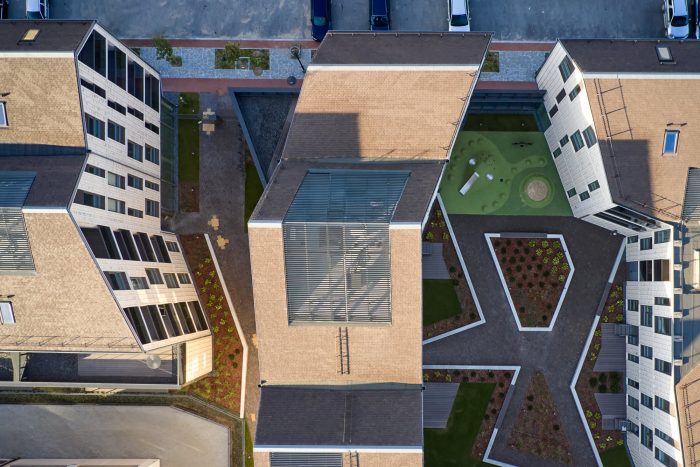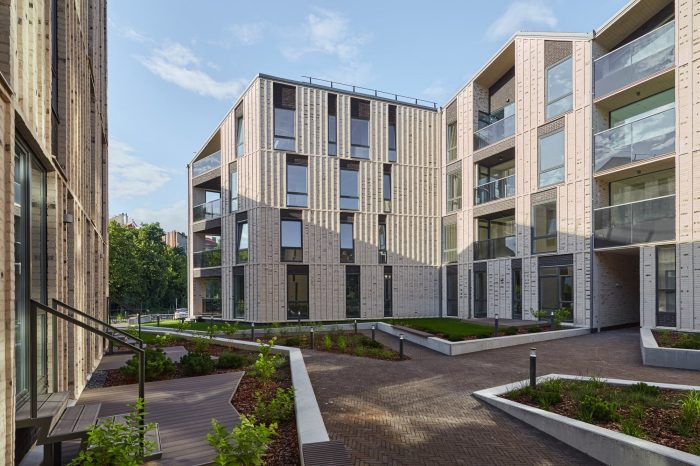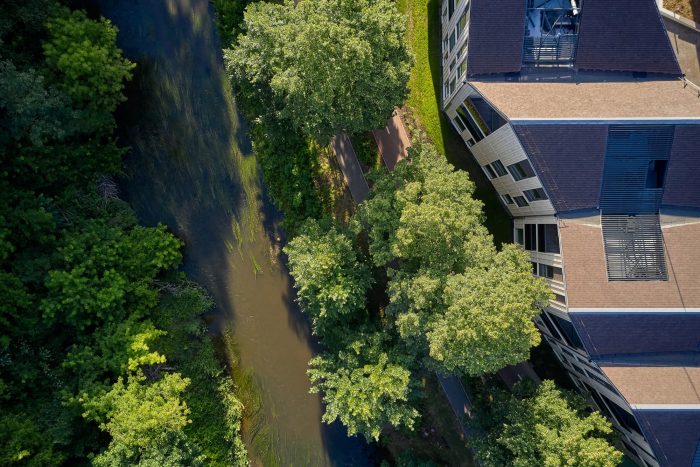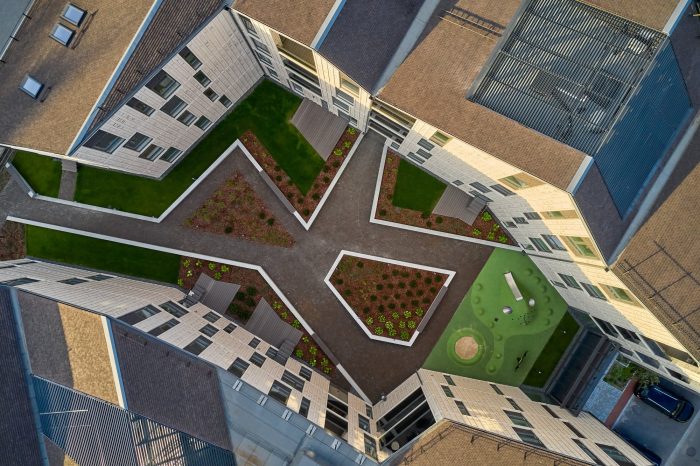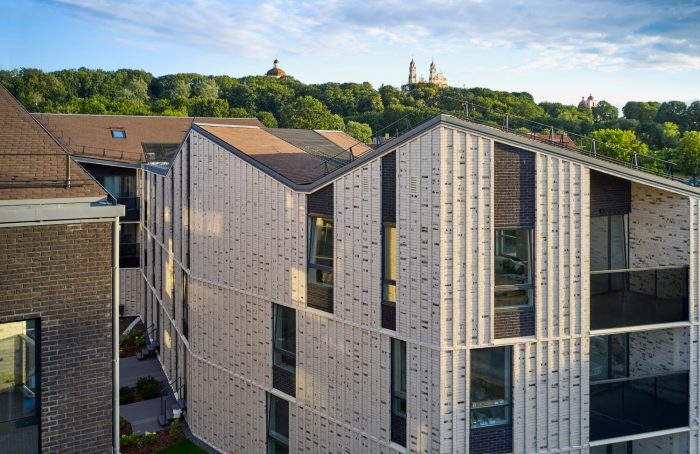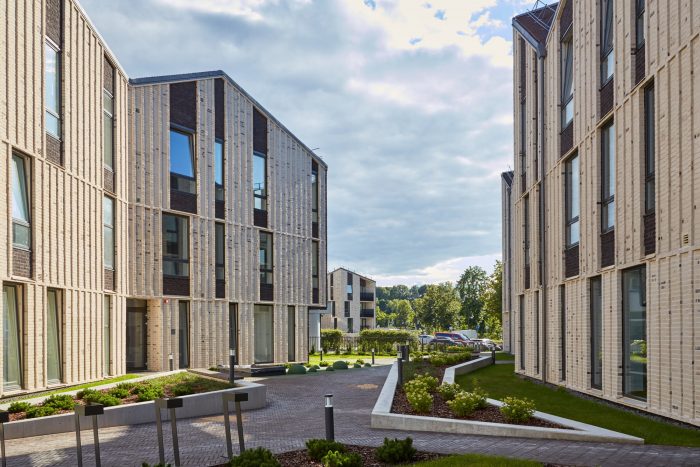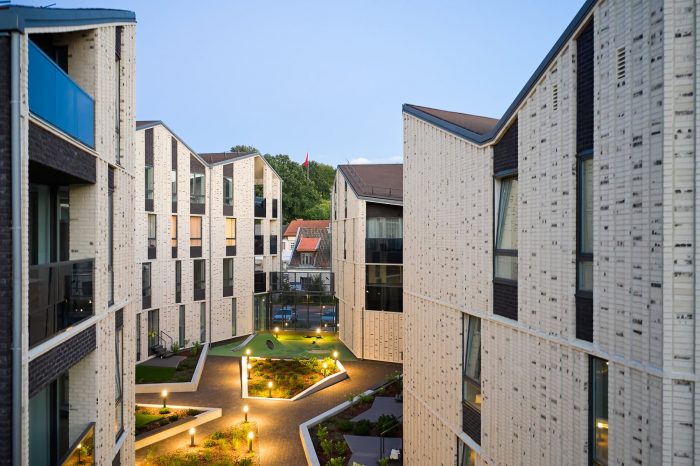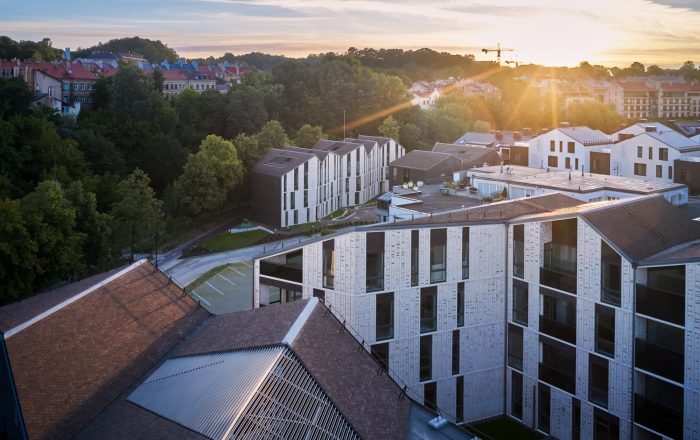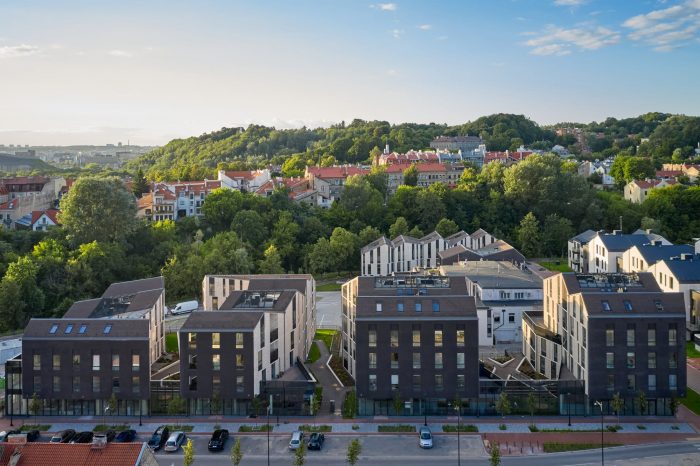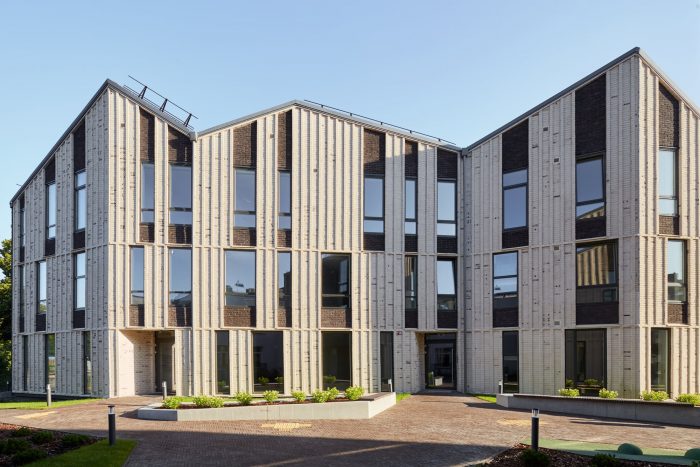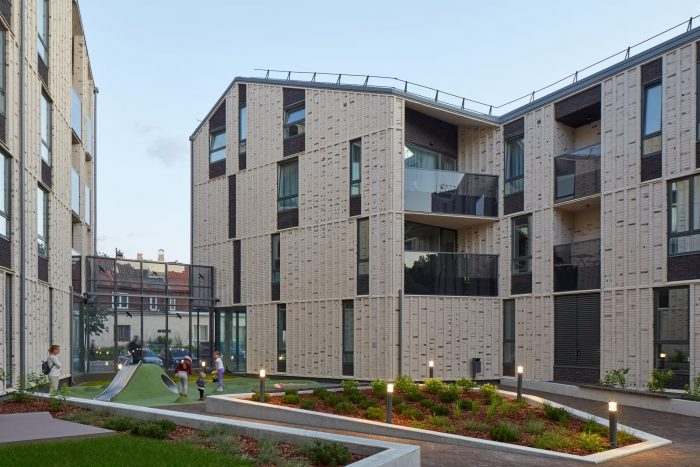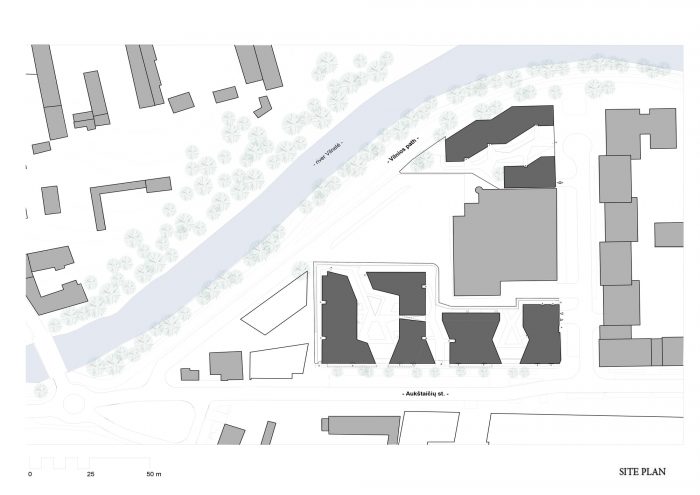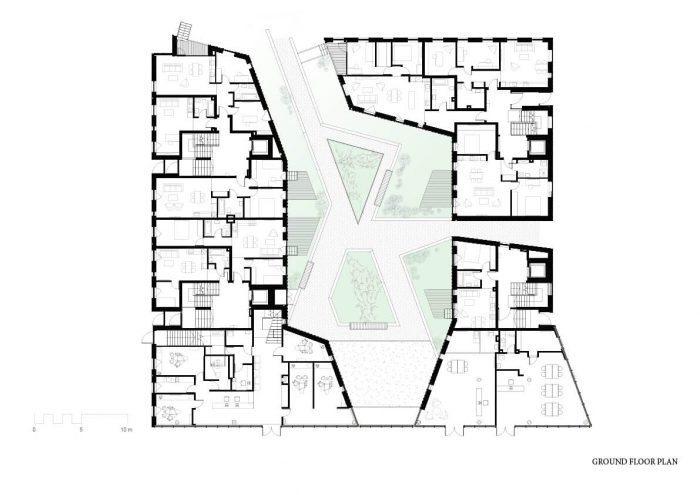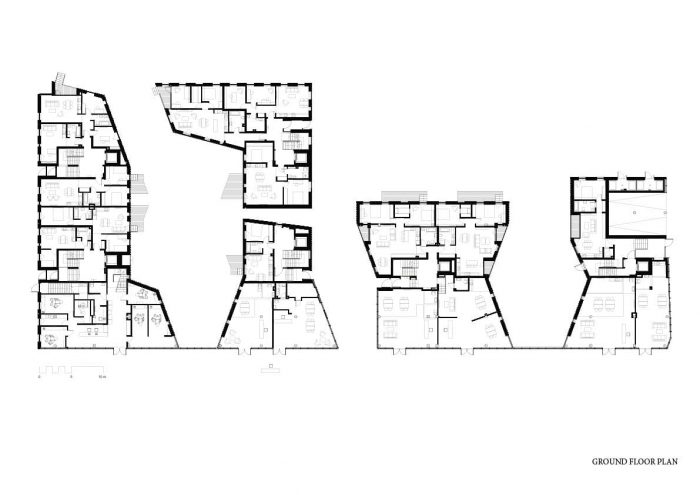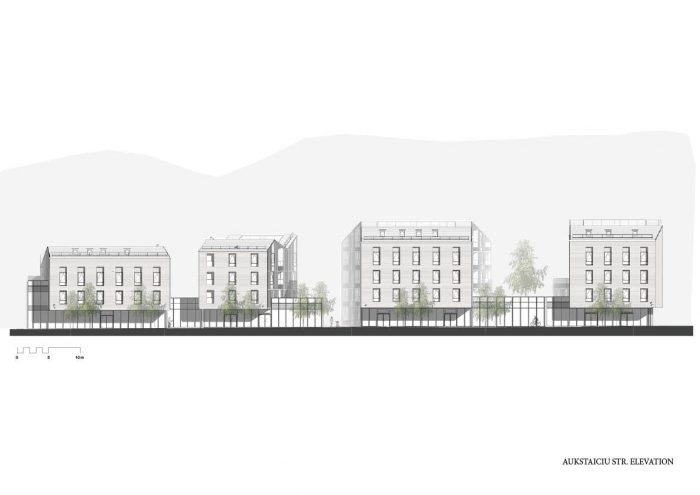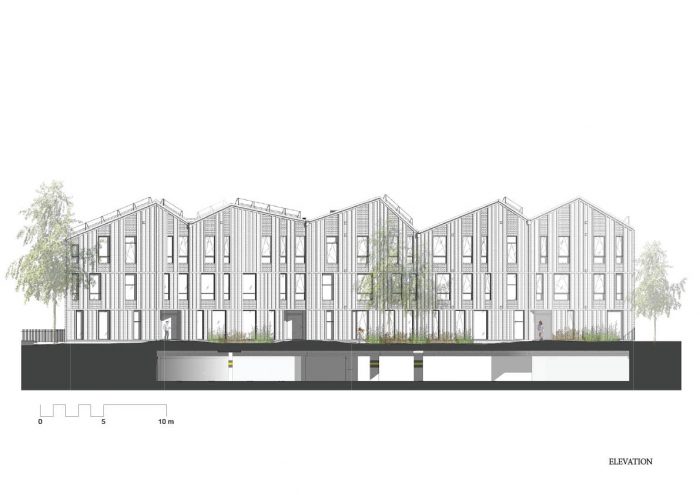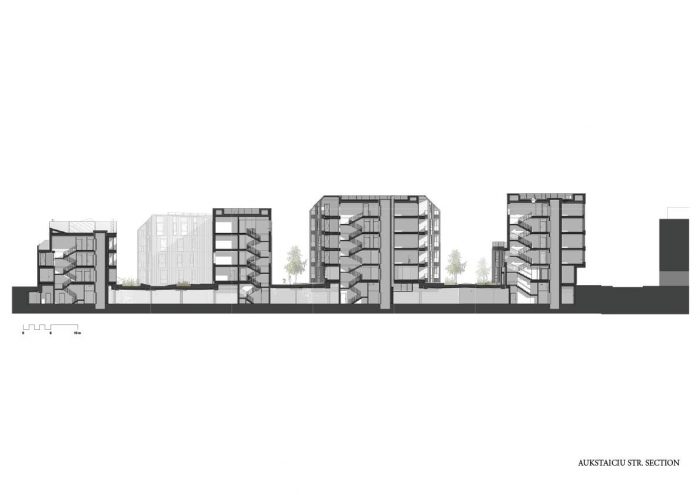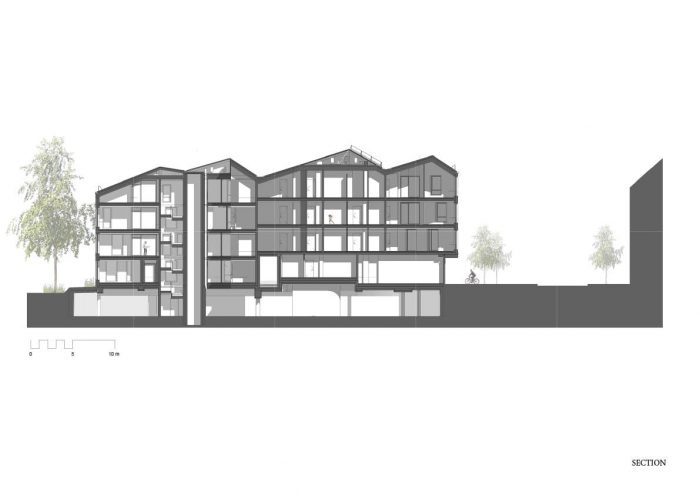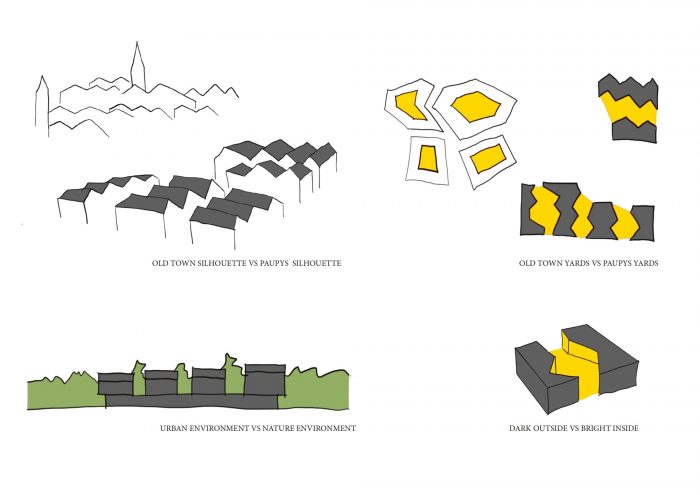在维尔纽斯这个历史悠久的城市中,通过培养百年的生活传统,将富有表现力的环境和人造的建筑群结合起来,开始创建一个独特的城市建筑住宅公园。这是联合国教科文组织的保护区域,位于立陶宛维尔纽斯老城,那里的工业已经存在多年,在维尔内莱河的山谷中,它的山坡结合了具体的特点和限制,同时为居民提供了一个特殊的生活质量。
By fostering a hundred years of traditions of living in the remarkable historical city of Vilnius, where the expressive environment and man-made architectural ensemble, were combined, the creation of a unique residential urban-architectural park, was started. It is UNESCO-protected area, located in the Old Town of Vilnius Lithuania, where the industry has existed for many years, in the valley of the Vilnelė River, which stands out on its slopes combined with specific characteristics, and constraints while offering residents an exceptional quality, of life.
新区被划分为不同的区,由立陶宛的不同建筑事务所设计。河滨庭院区就像一个大门,是老城区到新形成的部分的过渡。因此,在开发概念设计时,我们集中于与环境和人类的协同界面和相互联系,我们旨在利用现有场地的独特特征。老城区的独特特征之一是A型坡屋顶–它所形成的多面剪影,与山丘和河流的斜坡和弯道和谐地融合在一起。我们在设计的综合体中也应用了这一特点,体量的起伏轮廓以上升的曲线相互传递,远离了老城区和河流。
The new district was divided, into separate quarters, which were designed by different architectural offices from Lithuania. The Riverside courtyard quarter becomes like a gate, a transition from the old city to the newly shaped part. Therefore, while developing concept design, we concentrated on synergetic interfaces and interconnection with the environment and human, we aimed to use its unique features of the existing site. One of the exclusive characteristics of the Old Town is the gabled A shape roof – the multi-faceted silhouettes formed by it, harmoniously merging with the hills and river slopes and bends. We also applied this feature in our designed complex, where the undulating outlines of the volumes pass to each other in ascending curves, moving away from the old town and the river.
环境空间的第二个特殊形态特征是不规则形状的庭院系统,这使得即使在密集的建筑区也有封闭、安全的社区空间。后者的特点不仅成为我们小区内部的主题,而且还赋予了小区的名字–河边庭院。
The second exceptional morphological characteristic of environmental spaces is the irregularly shaped system of courtyards, which allows having closed, safe community spaces even in the densely built-up area. The latter feature became not only the leitmotif of the interiors of our quarter but also gave the name of the quarter – Riverside courtyards.
该地块的第三个特点是邻近的绿色河坡和河流本身的临近。我们认为,市中心的这种元素不应该被隐藏,或不被利用,所以住宅区的创建一直遵循着开放城市主要街道空间与绿色山体的意见的规定。建筑物之间留有空间缝隙,在那里我们用透明的玻璃墙形成街道的周边,这使得我们可以为居民的庭院创造私人空间,同时向所有的城镇居民开放河流的景观。
The third feature of the site is the adjacent green slopes of the river and the proximity of the river itself. We believe that such elements in the city centre should not be hidden, or not utilized, so the creation of the residential complex has consistently followed the provision to open the views of the main urban street spaces to the green massifs. Space gaps were left, between the buildings, where we formed the perimeter of the street with clear glass walls-joints that allowed to create private spaces for the residents’ courtyards while opening up views of the river to all the townspeople.
第四个环境特征是光和它的复合世界方向的位置。该地块位于河坡上,河坡上长满了老树,这就造成了光线问题。另外,河流在场地的北侧,所以它产生了北部景观的开放视野和南部的自然光和城市街道之间的冲突。因此,我们引入了一个横向空间系统的选择,使自然光在室内空间内相互作用,同时,整个区域的庭院和街道的美丽景色也被纳入其中。
The fourth environment feature is the light and its position of compound world direction. The site territory is located, on the river slopes, which is overgrown with old trees, and it creates a light problem. Also, the river is on the Northside of the site, so it generates conflict between open views to a landscape in the North, natural light and city streets in the South. So we introduced an option of transverse space system that allows natural light to interact within interior spaces, as well as, beautiful views of courtyard and street throughout the entire area.
舒适的光线、安静街区的内部和周围街道上激烈的公共生活的外部的二分法也被编码在颜色和纹理的外墙解决方案中:庭院由超亮的3D砖制成,有助于最大限度地提高暗光的数量,沉闷的砖创造了一个不朽的印象,持续,形成一个自我保护的季度的想法。这种二分法也被记录在立面窗户的构成中,这些元素在外部立面的排列方式非常有条理,保持着严格的节奏,而内部庭院的窗户则是独立的构成。
The dichotomy of cosy light, the interior of a quiet neighbourhood and the exterior of intense public life in the surrounding streets are also coded, in colour and textured façade solutions: courtyards are made, of ultra-bright 3D bricks that help maximize the amount of dark light, dulcet bricks that create the impression of a monumental, sustained, forming an idea of the self-preserving quarter. This dichotomy is also recorded, in the compositions of façade windows, where these elements in the external façades are arranged in a remarkably organized manner, maintaining a strict rhythm, and the windows in the inner courtyards are independent compositions.
该建筑群由六座独立的建筑组成,中间有庭院。当你远离老城区,沿着主要街道的人行道,建筑物的高度会增加。类似的推理也被保留了下来,关于河流:Vilnelė附近的建筑结构较低,当它远离时重复其弯曲,接近主街道–体积扩大。它确保了环境中住宅建筑群的和谐和轮廓,为居住在该区深处的居民或客人打开了河流和老城的视野。
The complex consists of six separate buildings that have courtyards in between. The height of the buildings increases as you move away from the Old Town, along the main street pavement. Similar reasoning was maintained, concerning the river: the building structures near Vilnelė are lower, it repeats its bends as it moves away, approaching the main street – the volumes expand. It ensures harmony and silhouette of the residential complex within the environment, that opens the views of the river and Old Town, to the residents or guests residing in the depths of the quarter.
庭院体量的断裂不仅有助于创造空间安排,表明环境之间的关系,而且是严格出于绝缘计算的动机。每个立面平面的转角必须最大限度地增加来光量,以及现有景观和教堂塔楼的开放视野。整个建筑群的居民汽车存放在位于地块下的地下停车场,所有的庭院只为居民、绿地和操场设计。每个院子都被划分为不同的空间,形成不同的功能,从而照顾到所有居民的利益:为老年人提供娱乐空间,城市耕作区,操场和私人露台(为一楼的居民)。
Fractures in courtyard volumes not only help to create spatial arrangements that indicate the relationship between the environment but are strictly motivated by insulative calculations. The turning angle of each façade plane must maximize the amount of coming light, as well as open views of existing landscape and church towers. The resident cars of the whole complex stored, in underground car parks situated under plots, all courtyards are designed only for residents, green areas and playgrounds. Each yard are divided into separate spaces that form functions for different purposes, thus taking care of the interest of all residents: spaces for recreation for the elderly, urban farming zones, playgrounds and private terraces (for the residents of the first floors), are provided.
通过调整可变高度的挡土墙,可以设计出一个丘陵的浮雕,反映了现有环境的特点,与结构的组合,作为一个整体组成。该建筑群中的所有公寓都有阳台或凹陷的阳台,因此不仅保持了体积的完整性,而且保证了居民的隐私。为了使结构体量不受影响,烟囱被隐藏在技术庇护所中,雨水管道的檐口被创造出来,屋顶覆层瓦片被连接并与外墙的纹理融合在一起。
By adapting variable-height retaining walls, allows designing a hilly relief, that mirrors a characteristic of the existing environment combined with an ensemble of the structure, as a whole composition. All apartments in the complex, have terraces, or recessed balconies, so not only the integrity of the volume is maintained, but the privacy of the residents, is ensured. To monumentalize the structure volumes chimneys are hidden, in technical shelters, cornices of rainwater pipes created, roof cladding tiles connected and merged with the texture of the façade.
它允许创造一个有机的脉动,在城市最宝贵的全景中可见的建筑群,结合几乎所有可能的人所需要的属性:自然、私人空间、社交场所、工作区、与历史的直接联系。
It allows creating an organically pulsating, cohesive architectural ensemble visible in the most valuable panoramas of the city, combining almost all possible attributes necessary for a person: nature, private space, places of socialization, work areas, direct connection with history.
Architects: arches
Area : 11320 m²
Year : 2020
Photographs :Norbert Tukaj
Manufacturers : Nelissen, Megrame Medis, Imerys, Marx
Lead Architect : Edgaras Neniškis
City:VILNIUS
Country:Lithuania

